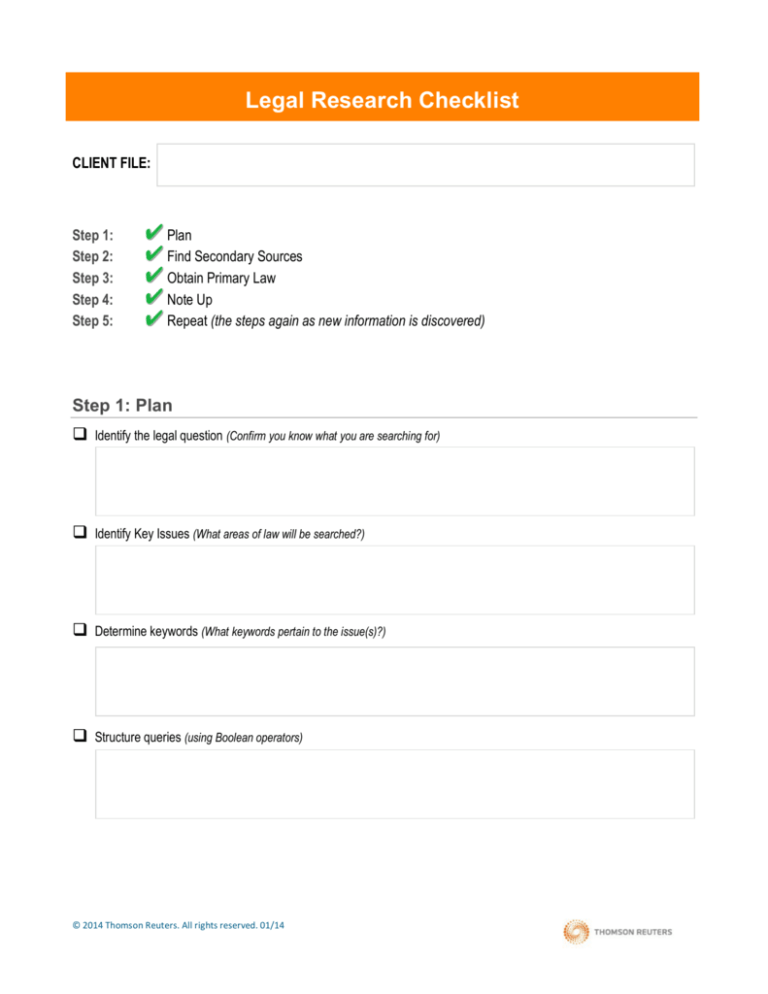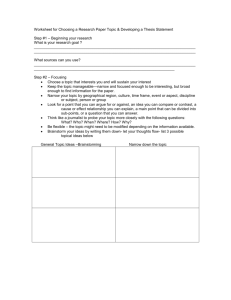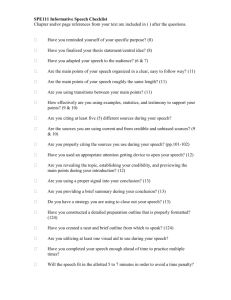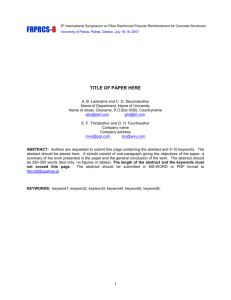
Legal Research Checklist
CLIENT FILE:
Step 1:
Step 2:
Step 3:
Step 4:
Step 5:
Plan
Find Secondary Sources
Obtain Primary Law
Note Up
Repeat (the steps again as new information is discovered)
Step 1: Plan
Identify the legal question (Confirm you know what you are searching for)
Identify Key Issues (What areas of law will be searched?)
Determine keywords (What keywords pertain to the issue(s)?)
Structure queries (using Boolean operators)
© 2014 Thomson Reuters. All rights reserved. 01/14
Step 2: Find Secondary Sources
A. Canadian Encyclopedia Digests (CED)
(a) Browse
(b) Search
Find main issue; drill down to specific topic
Read overview paragraph(s) and ID pertinent keywords
From Footnotes:
Find case(s):
Read full text
Follow Step 3B (Obtain Primary Law – Case Law)
Find legislation: Follow Step 3C (Obtain Primary Law – Legislation)
Select the Abridgment Digests Classification link located above the paragraphs to retrieve digests: get
the case summaries on point for the specific issue
Search using keywords identified in Step 1 and 2A
Refine search using Filters in the Narrow section
Follow steps in 2A
B. Legal Memoranda and Points of Law – Browse
Find main issue; drill down to specific topic
Link to Legal Memoranda summary page for desired legal issue
Retrieve cases and legislation on point for Legal Issue
C. Law Report Articles and Journals - Search
Search using keywords identified in Step 1 and 2A
Refine search using Filters in the Narrow section
Verify cases and legislation referred to in Footnotes
D. Index to Canadian Legal Literature – Search or Browse
Search using keywords, subject headings and applicable legislation
Browse the Table of Subject Headings and cross references; useful for discovering indexed terms to employ in
searching
If link to full text article is not available, request article from firm library or courthouse library
E. Legal definitions - Search
Judicial definitions: Use the Advanced Search template for Words & Phrases
Legislative definitions: In the Advanced Search template for Statutes and Regulations, use the Defined Term
field
F. Find books in the Library
Annotations
Practice Guides
Loose-Leaf Services
Legal Dictionaries
2
Step 3: Obtain Primary Law
A. Canadian Abridgment Digests
(a) Browse
(b) Search
B. Case Law
Find main issue; drill down to specific topic
Read digest summaries dealing with specific point of law and identify pertinent keywords
Link to and read full text of cases
See Citing References to note up case(s) (see Step 4)
Verify Secondary Sources for articles, CED paragraphs and texts referring
to the case in question
See Legal Memos for Memo Summary pages with Legal Issues on point (if applicable)
See Court Memos for pleadings, motions, facta/briefs (if applicable)
Search using keywords identified in Step 1 and 3A
Follow steps in 3A above
Obtain relevant cases from secondary sources (Step 2)
Find cases by name or by citation
See Citing References to note up case(s) (Step 4)
See Legal Memos for Memo Summary pages with Legal Issues on point (if applicable)
See Court Memos for pleadings, motions, facta/briefs (if applicable)
Search using keywords and applicable fields (jurisdiction, subject, date, judge, counsel, Headnote, etc.)
Refine search using Filters in the Narrow section
See Citing References to note up case(s) (Step 4)
See Legal Memos for Memo Summary pages Legal Issues on point (if applicable)
See Court Memos for pleadings, motions, facta/briefs (if applicable)
C. Legislation
Obtain relevant legislation from secondary sources (Step 2)
Find legislation by name or citation
See Citing References to note up legislation (Step 4)
See Annotations (if applicable)
See Legal Memos for Memo Summary pages with Legal Issues on point (if applicable)
Search using keywords, and applicable fields (short title, jurisdiction, defined term)
Refine search using Filters in the Narrow section
See Citing References to note up legislation (Step 4)
See Annotations (if applicable)
See Legal Memos for Memo Summary pages with Legal Issues on point (if applicable)
3
Step 4: Note Up
A. For case law
Verify if a case has been appealed to a higher court and how it was treated by that court (See History)
Determine the judicial treatment of the case (See Citing References)
Use Citing References to:
See how often the cases considering your case have been judicially considered
Narrow the citing reference list (use Filters in the Narrow section) by keyword, jurisdiction, judicial
treatment, citation frequency, date, court/level, and/or depth of treatment
Verify Secondary Sources for articles, CED paragraphs and texts referring to the case in question
B. For legislation
Verify how the courts have treated or considered a particular statute, regulation or rule (See Citing
References)
Use Citing References to:
See how often the cases considering the statutory provision have been judicially considered
Narrow the citing reference list (using Filters in the Narrow section) by keyword, legislative
subsection or clause, jurisdiction, judicial treatment, citation frequency, date, court/level and/or depth
of treatment
Step 5: Repeat!
Repeat the research process to fine tune your results as you uncover additional information.
Use History to revisit earlier results and to keep a record of the research you’ve done.
Save your documents into Folders for future reference.
Print, email, or download your results.
Copy selected portions of documents using the Copy with Reference function (located in the pop-up window
after highlighting text snippets)
For additional information visit the Customer Learning Centre: (www.carswell.com/learning).
4









